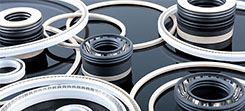Proper Installation Of Skeleton Oil Seals: Ensuring Optimal Performance
Aug 16, 2024
Skeleton oil seals, also known as skeletal rubber seals, play a vital role in preventing oil leakage and protecting bearings from dust and moisture. These seals are commonly used in various mechanical devices, including industrial equipment, automobiles, motorcycles, and bicycles. Proper installation of skeleton oil seals is essential for maintaining the integrity of the seal and ensuring the smooth operation of the machinery.
Installation Direction and Method for Skeleton Oil Seals
Preparation for Installation
Before starting the installation process, ensure that the installation area is clean and free of dust, oil, or other foreign substances. This step is crucial to prevent contamination that could affect the seal's performance.
Inspection of the Seal
Carefully inspect the skeleton oil seal for any signs of damage or wear. Ensure that the rubber portion of the seal is free from cracks or defects that could compromise its sealing capabilities.
Determine the Installation Direction
Most skeleton oil seals come with a directional mark indicating the correct installation orientation. This mark, often in the form of an arrow or rotation direction, should be followed precisely during installation to ensure proper function.
Seal Installation
Gently place the seal onto the shaft, making sure that the rubber portion of the skeleton oil seal makes a snug fit against the shaft. Proper alignment is key to preventing leaks and ensuring effective sealing.
Pressing the Seal into Place
Using a specialized tool or a wrench, carefully press the seal into its position on the shaft. Apply even pressure to avoid damaging the seal. Excessive force should be avoided to prevent deformation or damage to the seal.
Installation of the Shaft Sleeve or Bearing
After positioning the seal, install the shaft sleeve or bearing adjacent to the seal. Ensure that the gap between the seal and these components meets the required specifications.
Confirm Installation
Once installed, verify that the seal is not twisted or damaged and that it can rotate smoothly. A correctly installed seal should maintain its shape and provide a consistent seal around the shaft.
Lubrication and Testing
After installation, lubricate the bearing and test the machinery to ensure it operates smoothly without leaks or issues. Proper lubrication is essential for reducing wear and extending the seal's lifespan.
Conclusion
Improper installation of skeleton oil seals can lead to leaks, damage, or premature wear of the bearings. By following the correct installation procedures, you can ensure that the seals perform their intended function, providing reliable protection for your machinery. Proper installation not only enhances the seal's effectiveness but also contributes to the overall longevity and efficiency of the equipment.
For more information or assistance with selecting and installing skeleton oil seals, feel free to contact our team of experts. We are committed to helping you maintain the optimal performance of your machinery.


 News
News
 Industry information
Industry information




